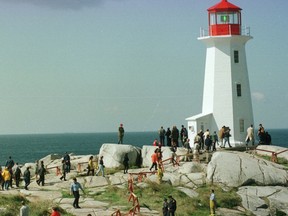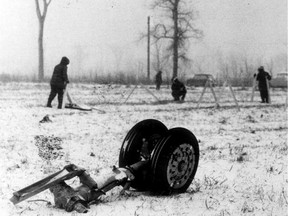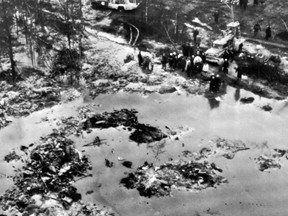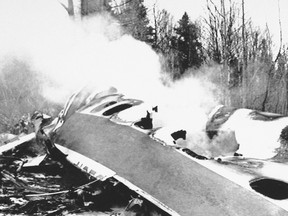The plane crash with the most fatalities on Canadian soil occurred in 1985 in Gander, Newfoundland
Article content
Throughout history, there have been many plane crashes on Canadian soil. Here’s a look back at three of Canada’s worst.
Deadliest plane crash on Canadian soil was in 1985
Canada’s deadliest plane crash was 40 years ago in Gander, Newfoundland. It crashed 73 seconds after takeoff on Dec. 12, 1985, St. John’s publication The Telegraph reported in 2010. All of the passengers — 256 total — died. There were eight crew members and 248 U.S. soldiers on board.
Advertisement 2
Article content
Aviation publication Simple Flying said it was the “deadliest air accident to ever occur in Canada.”
Arrow Air Flight 1285 was travelling to Fort Campbell, which is located along the Kentucky-Tennessee border, from Egypt, where the soldiers were conducting a peacekeeping mission, per The Telegraph. The plane first stopped in Cologne, Germany, and then landed in Gander before its intended final destination.
Just after the plane took off from Gander, one witness, Headly Gill, told The Telegraph that he saw “an explosion at the end of the runway.”
“(The plane) had just lifted off the runway and — bang! You could have seen it anywhere in town,” he said. “It wasn’t quite light out and it was this big ball of fire.”
The Canadian Aviation Safety Board, the agency that was then in charge of the investigation, published a 141-page report. It was unable to determine the exact cause of the crash, but supported the “conclusion that, shortly after lift-off, the aircraft experienced an increase in drag and reduction in lift which resulted in a stall at low altitude from which recovery was not possible,” per the report.
Article content
Advertisement 3
Article content
“The most probable cause of the stall was determined to be ice contamination on the leading edge and upper surface of the wing. Other possible factors such as a loss of thrust from the number four engine and inappropriate take-off reference speeds may have compounded the effects of the contamination,” the report stated.
A 1998 plane crash in Nova Scotia left 229 dead
A Swissair flight left a total of 229 people dead after it plunged into Nova Scotian waters on Sept. 2, 1998, the Canadian Press reported. Swissair Flight 111 was bound for Geneva, departing from New York City.

Nearly an hour after takeoff, flying at 33,000 feet in the air, the flight crew smelled an odour coming from the cockpit, according to the Transportation Safety Board of Canada (TSB). “A small amount of smoke became visible in the cockpit; then, it is likely that the smoke stopped entering the cockpit for an undetermined length of time,” per the TSB.
The crew believed it was an “anomaly associated with the air conditioning system.” They decided to divert the aircraft to the Halifax International Airport. However, less than 15 minutes after the crew smelled smoke, there was a “rapid succession of aircraft systems-related failures.” After losing contact with air traffic services, the plane plummeted into the Atlantic Ocean off the coast of Nova Scotia, near Peggy’s Cove.
Advertisement 4
Article content
“From the examination of the pieces of wreckage, it was determined that a fire had occurred in the forward, overhead area of the aircraft,” the TSB said. “It was determined that the fire most likely started from an electrical arcing event that occurred above the ceiling on the right side of the cockpit near the cockpit rear wall.”
In its 351-page report, the TSB made safety recommendations, many of which have been implemented.
Vic Gerden, who led the TSB investigation, told the Canadian Press: “Perhaps the most significant change is that certain flammable materials such as (metallized polyethylene terephthalate) MPET are no longer used in aircraft, reducing the risk of in-flight fires.”
Fatal plane crash in Montreal left 118 dead in 1963

On Nov. 29, 1963, 118 people died after a plane crashed into a wooded area in Blainville, Quebec, outside of Montreal, the Montreal Gazette reported.
The flight was set to land in Toronto — but nearly five minutes after takeoff, all passengers on board Trans-Canada Air Lines Flight 831 were killed. (Trans-Canada Air Lines was renamed Air Canada in 1965.)
Advertisement 5
Article content

A 1964 report “concluded that the actual cause of the accident cannot be determined with certainty.” However, “the most probable chain of events,” as summarized by the Aviation Safety Network, explained that “the pilot applied the near maximum available Aircraft Nose Down (AND) Trim to the horizontal stabilizer.”
It continued: “The aircraft then commenced a diving descent building up speed at such a rate that any attempted recovery was ineffective because the stabilizer hydraulic motor had stalled, thus making it impossible within the altitude available to trim the aircraft out of the extreme AND position.”
Recommended from Editorial
Our website is the place for the latest breaking news, exclusive scoops, longreads and provocative commentary. Please bookmark nationalpost.com and sign up for our daily newsletter, Posted, here.
Article content









